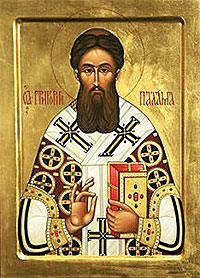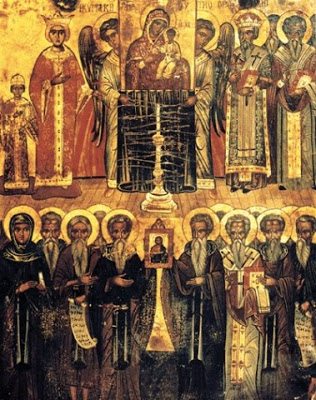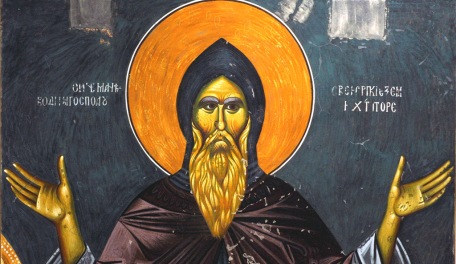Theology
Sermon by Newly-Canonized Serbian Bishop Mardarije (Uskokovic) on the Second Sunday of Great Lent, Delivered at the Church of Saint Olga Orphanage in Kishinev.
4. March 2018 - 2:20 My dear children. I visited your wealthy and valuable library, I saw very many interesting and beneficial books on various topics and saw you often reading these fine tomes. But to my great sorrow and disappointment, I did not see the most important of all books. I looked throughout the library and could not find a single Bible. You are not to blame for this, nor are your teachers, it is the spirit of the time that is to blame, contemporary society. This wonderful book is very hard to find even in the most eminent homes. It is considered to be an old, boring book whose days have passed. Oh how cruelly are people mistaken! There is no book more valuable than the Bible. There was not and will not ever be another book which can replace the Bible.
My dear children. I visited your wealthy and valuable library, I saw very many interesting and beneficial books on various topics and saw you often reading these fine tomes. But to my great sorrow and disappointment, I did not see the most important of all books. I looked throughout the library and could not find a single Bible. You are not to blame for this, nor are your teachers, it is the spirit of the time that is to blame, contemporary society. This wonderful book is very hard to find even in the most eminent homes. It is considered to be an old, boring book whose days have passed. Oh how cruelly are people mistaken! There is no book more valuable than the Bible. There was not and will not ever be another book which can replace the Bible.
Synodikon of Orthodoxy
25. February 2018 - 2:16 The text of the Synodikon of Orthodoxy has been much altered over the centuries, chiefly by the addition of material and names that postdate the Restoration of the Icons in 843. This is the case with the text that is printed in the current Triodia. Some of the more zealous contemporary Orthodox even include condemnations of such things as the ‘pan-heresy of Ecumenism‘. It is probably impossible to reconstruct the original text exactly. However the British Library possesses a manuscript, (BL. Additional 28816) written in 1110 or 1111 by a monk Andrew of the monastery of Oleni in Moraea, which may give some idea of the scope and contents of the original. In the opinion of Jean Gouillard, the editor of the critical edition of the Synodikon, ‘the London manuscript is certainly one of the best witnesses to the primitive and purely Constantinopolitan form of the Synodikon’. The manuscript was unknown to him when he prepared his edition and has in consequence been generally neglected.
The text of the Synodikon of Orthodoxy has been much altered over the centuries, chiefly by the addition of material and names that postdate the Restoration of the Icons in 843. This is the case with the text that is printed in the current Triodia. Some of the more zealous contemporary Orthodox even include condemnations of such things as the ‘pan-heresy of Ecumenism‘. It is probably impossible to reconstruct the original text exactly. However the British Library possesses a manuscript, (BL. Additional 28816) written in 1110 or 1111 by a monk Andrew of the monastery of Oleni in Moraea, which may give some idea of the scope and contents of the original. In the opinion of Jean Gouillard, the editor of the critical edition of the Synodikon, ‘the London manuscript is certainly one of the best witnesses to the primitive and purely Constantinopolitan form of the Synodikon’. The manuscript was unknown to him when he prepared his edition and has in consequence been generally neglected.
Hieromartyr Charalampus (Haralambos) the Bishop of Magnesia in Thessaly
22. February 2018 - 16:27 The Hieromartyr Charalampus, Bishop of Magnesia, the Martyrs Porphyrius and Baptus and Three Women Martyrs suffered in the year 202.
The Hieromartyr Charalampus, Bishop of Magnesia, the Martyrs Porphyrius and Baptus and Three Women Martyrs suffered in the year 202.
Saint Charalampus, Bishop of Magnesia (Asia Minor), successfully spread faith in Christ the Savior, guiding people on the way to salvation. News of his preaching reached Lucian, the governor of the district, and the military commander Lucius. The saint was arrested and brought to trial, where he confessed his faith in Christ and refused to offer sacrifice to idols.
The Great Canon of St Andrew of Crete
20. February 2018 - 14:09
There is no other sacred hymn which compares with this monumental work, which St Andrew wrote for his personal meditations. Nothing else has its extensive typology and mystical explanations of the scripture, from both the Old and New Testaments. One can almost consider this hymn to be a “survey of the Old and New Testament”. Its other distinguishing features are a spirit of mournful humility, hope in God, and complex and beautiful Trinitarian Doxologies and hymns to the Theotokos in each Ode.
The Life of Venerable Simeon the Myrrh-Gusher
17. February 2018 - 9:06 On February 26th (February 13th according to Julian calendar) we commemorate: The Venerable Simeon (Myrrh-Gusher), from whose relics flowed myrrh – Chrism
On February 26th (February 13th according to Julian calendar) we commemorate: The Venerable Simeon (Myrrh-Gusher), from whose relics flowed myrrh – Chrism
Stefan Nemanja, the great ruler (Great Zupan) of the Serbian people, the consolidator of Serbian lands, creator of the independent Serbian state, defender of Orthodoxy and exterminator of heresy. At first, he was baptized in the Latin Church but later left this Church and embraced the Orthodox Church.
Martyr Tryphon of Lampsacus Near Apamea in Syria
14. February 2018 - 10:21 The Martyr Tryphon was born in Phrygia, one of the districts of Asia Minor, in the village of Lampsacus. From his early years the Lord granted him the power to cast out demons and to heal various maladies. He once saved the inhabitants of his native city from starvation. Saint Tryphon, by the power of his prayer, turned back a plague of locusts that were devouring the grain and devastating the fields.
The Martyr Tryphon was born in Phrygia, one of the districts of Asia Minor, in the village of Lampsacus. From his early years the Lord granted him the power to cast out demons and to heal various maladies. He once saved the inhabitants of his native city from starvation. Saint Tryphon, by the power of his prayer, turned back a plague of locusts that were devouring the grain and devastating the fields.

